Syunik churches and monasteries: Armenia’s majestic frontier in a nutshell
June 05, 2021
Once again Armenia’s borderlands are in distress. Syunik, the fortified realm of Armenian kingdoms, princedoms and dioceses with two millennia of turbulent history, is braced for its next reckoning as a pillar of defense against foreign powers—one of the toughest since the announcement of the independence of the Republic of Mountainous Armenia in 1921.
Incorporated into fortresses, covered with forests, or towering over massive gorges, Syunik’s breathtaking churches and monasteries have become a symbol of continuous presence in Armenia’s southernmost province; their evocative power bringing us closer to our own reality and identity as bearers of our rich heritage.
At h-pem we take a bird’s eye view of the region's age-old monastic and cultural legacy that thrived through wars, invasions, and occupations, to become a cornerstone of enlightenment and spiritual renewal in the Armenian world.
Like a vast grotto it is simple and profound, dark and light –
With its hospitable court, ample tribune, and hushed altar
Standing in the distance as though it were a ship afloat.”
Ինչպես քարայր մ’ընդարձակ, պարզ ու խորհուրդ, մութ ու լոյս,
Իր գաւիթովն հիւրընկալ, իր լայն բեմով, ու հեռուն
Կանգնած իր լուռ խորանով, որ կարծես նաւ մ’ է ծփուն…»
.jpg) Tatev Monastery (Photo: Wikimedia Commons)
Tatev Monastery (Photo: Wikimedia Commons)Interesting facts: To the south of the Saints Paul and Peter Cathedral, a unique tenth century swinging column dedicated to the Holy Trinity tilts at the touch of your hand. It served as a warning system against invading troops and earth tremors; A recently renovated eighteenth century oil mill, with stone grinders and domed storages, is the best preserved among similar medieval structures in Armenia; Wings of Tatev, a cableway from Halidzor village to Tatev is included in the Guinness World Records as the “longest non-stop double track cable car” in the world.
Bgheno-Noravank Monastery is a unique bluish-grey basalt church tucked away in the deep woods, near the town of Shinuhayr. Designed to serve the ruling elite rather than parishioners, its four doorways created a link to the surrounding nature, rather than cut worshippers off from the outside world. In 1062, King Grigor I Ashotian of Syunik reconstructed the initial limestone church which was built in 963. With braided ornaments, nature inspired motifs, such as pomegranate branches, and biblical reliefs from the life of Christ, Bgheno-Noravank is second only to the early medieval Church of the Holy Cross on Akhtamar Island in terms of artistic achievement. The famous tenth century Echmiadzin Gospels were made in its scriptorium.
.jpg) Bgheno-Noravank (Photo: Wikimedia Commons)
Bgheno-Noravank (Photo: Wikimedia Commons)Interesting facts: The ruins of the monastery and surrounding walls were discovered in the 1920s, by the writer and agronomist Axel Bakunts; there were also special chambers reserved for the care of lepers.
.jpg) Bas-relief of what is thought to be national saints in the cloister of Bgheno-Noravank.
Bas-relief of what is thought to be national saints in the cloister of Bgheno-Noravank.
Vorotnavank Monastery dominates the Vorotan Gorge in Sisian and has been a pilgrimage site for those seeking healing from snakebite. Gregory the Illuminator founded an Armenian church here. Queen Shahantukhd of Syunik built the main church of St. Stepanos, its workshops, storages, alms-house, and defensive walls in 1000; her son, Prince Sevada, constructed the St. Karapet Church (both mother and son are buried at the cemetery). In 1104, Ivane Zakarian, Armenian military commander under Queen Tamar of Georgia, liberated the monastic stronghold from Seljuk Turks, and the Orbelian lords of Syunik turned it into a medieval hub of art, philosophy, and theology. The only surviving fresco in the St. Karapet Church depicts an angel at the center of a blue, starry sky.
Interesting facts: An underground passage connected the monastery to the fortress of Vorotnaberd; a pillar was designated for the ordination of priests and inauguration of kings.
St. Gregory the Illuminator Church rises twenty-eight meters high in the heart of Goris, against a backdrop of rugged hills. Descendants of the Princes Melik Husenians, together with the inhabitants of the city, raised funds for the construction of the church, which was consecrated by Khrimian Hayrik in 1903. The hexagon bricks are the most striking architectural feature of this church. During the Soviet era, it served as a bread storehouse, and a local history museum later on. Now the seat of the Diocese of Syunik of the Armenian Apostolic Church, it was opened to the public in 1997, after the completion of the dome and altar.
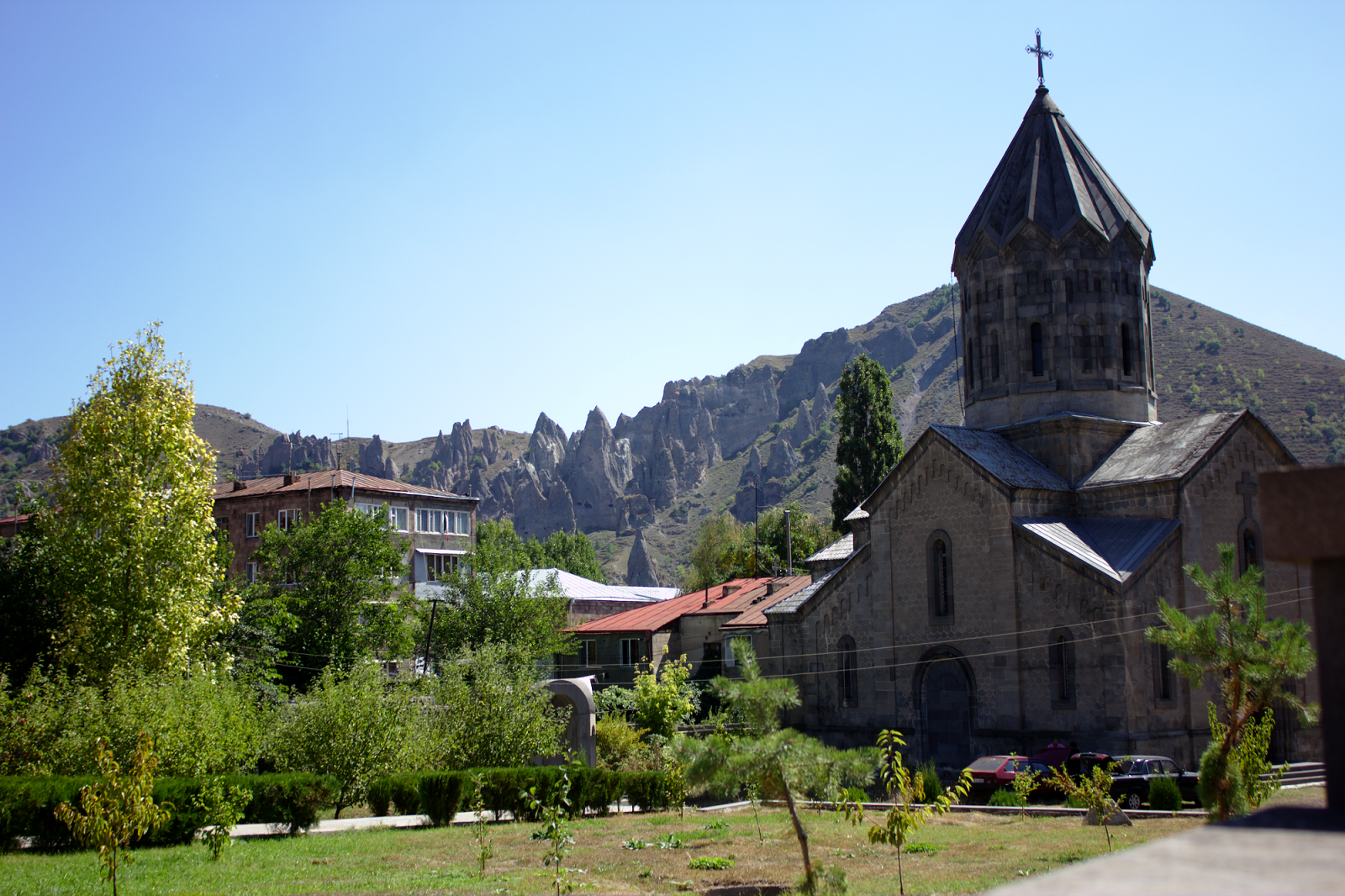 St. Gregory the Illuminator Church (Photo: Wikimedia Commons)
St. Gregory the Illuminator Church (Photo: Wikimedia Commons)Interesting facts: The national hero Garegin Njdeh was married here in 1920, and ordained supreme commander of the Republic of Mountainous Armenia in a religious ceremony the following year.
St. Gregory or Syuni Church of Sisian was mistakenly referred to as St. Hovhannes Church or Sisavank—the real name inscribed on its walls was forgotten due to continuous invasions and dispersion. Turkish rulers called it Gharakilise (black church), because of its bluish basalt walls. Facing the Vorotan River, the sixth-seventh century church was built on the site of a pagan temple by Princess Varazdukhd and reconstructed by Prince Kohazat of Syunik. The cross-domed church is one of the few early Armenian churches that has withstood the test of time. It is designed in the style of St. Hripsime Church. However, the space under the dome is square, decorated with bas-reliefs of the four evangelists and church benefactors.
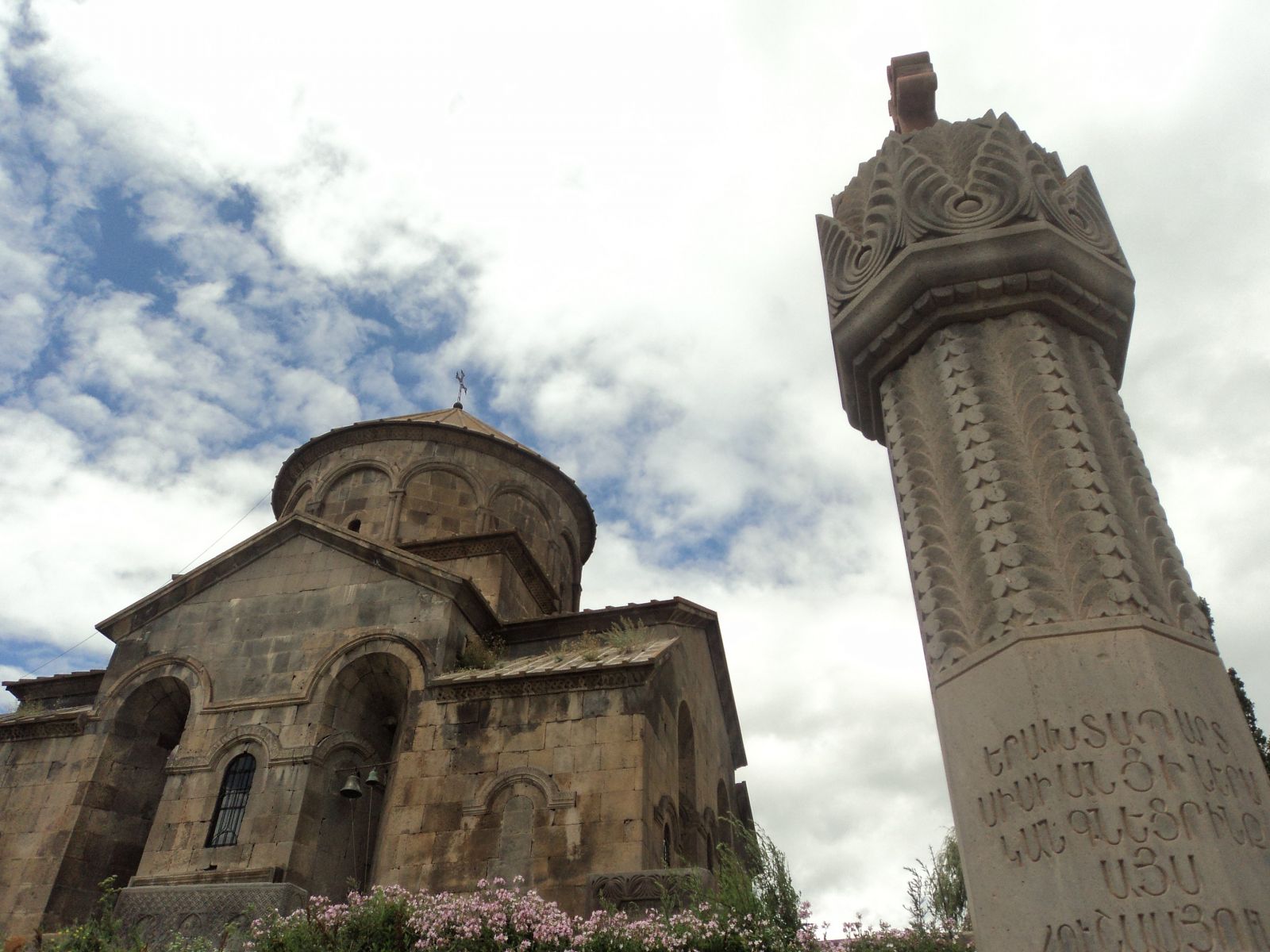 St. Gregory or Syuni Church (Photo: Dkyarunts, Wikimedia Commons)
St. Gregory or Syuni Church (Photo: Dkyarunts, Wikimedia Commons)Interesting facts: The Sisian-born micro miniaturist Edward Ghazaryan’s works are on display beside ancient manuscripts at the church; medieval tombstones of princes and priests rest near the pantheon dedicated to the natives of Sisian who have fought for the defense of Artsakh.
Vahanavank Monastery is nestled in the forests of Mount Tigranasar near Kapan, on the bank of Voghji River. It was founded as a spiritual center in 911 by Prince Vahan Nakhashinogh, who took religious vows to fight his demons—the monks at Vahanavank were austere and wore hair shirts. Inspired by the example of the Tatev Monastery, he went on to open a seminary with more than hundred preceptors to educate pupils from different parts of Syunik. One of them was his nephew, Vahan Jevanshir II, who became the Bishop and then Catholicos of Syunik. The monastery's cross-domed church, St. Gregory the Illuminator, is built of reddish basalt. The distinctive portico is supported by three massive horse-shoe shaped arches. In 1086 Queen Shahantukhd II of Syunik built the two-storied Holy Mother of God Church as a royal pantheon—the vaulted church, with a pillared balcony, is constructed above the crypt.
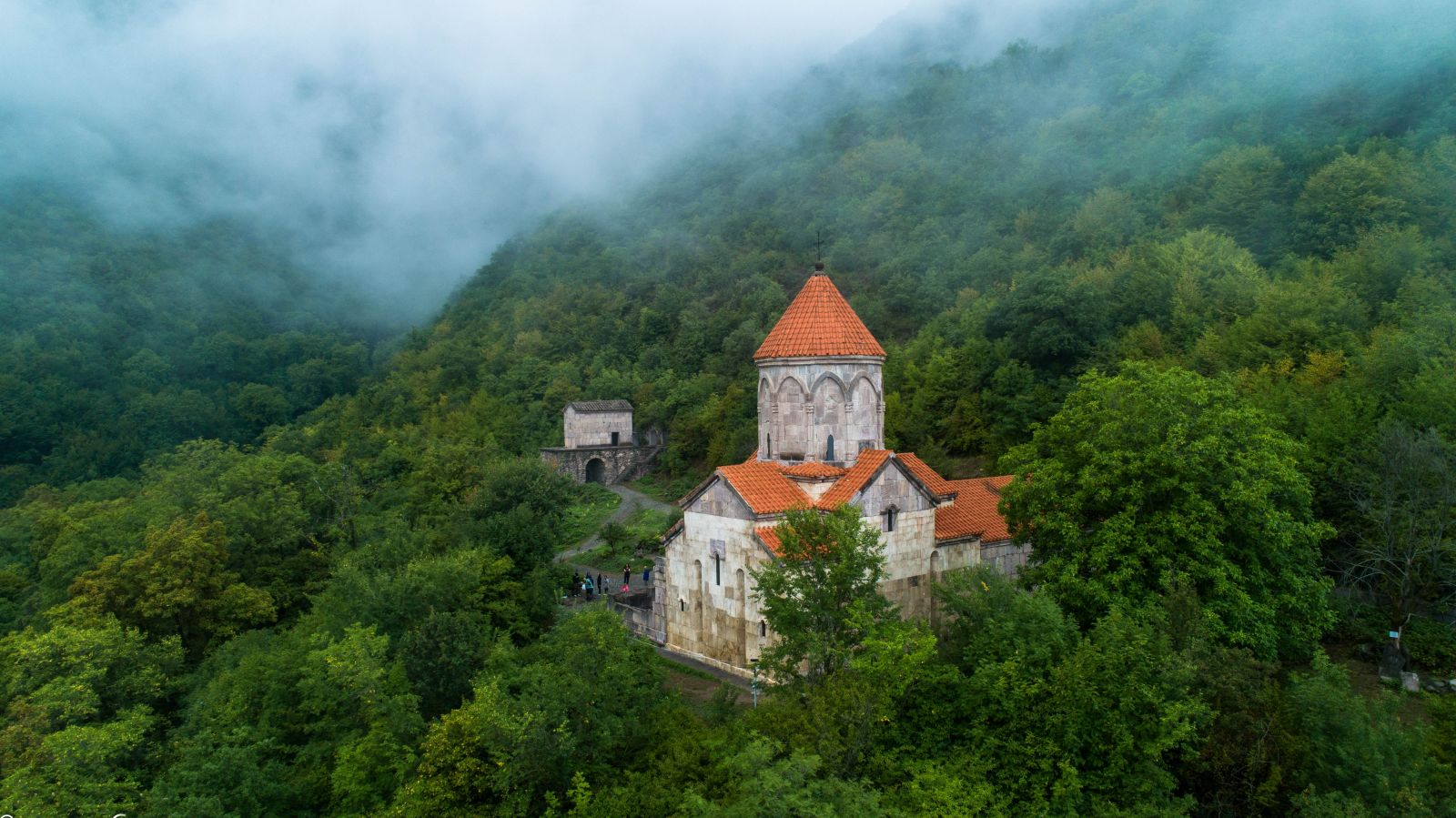 Vahanavank Monastery (Photo: Wikimedia Commons)
Vahanavank Monastery (Photo: Wikimedia Commons)Interesting facts: Invasions and earthquakes left the Vahanavank in ruins. It was reconstructed during Soviet times and covered with red roofs in 2006; excavations have yielded clay pipes for conducting water—still operating, pottery, and medieval coins.
Holy Mother of God Church stands in the Large Quarter at the heart of Meghri, the last town with the border of Iran. Built in 1673, it is a rather unusual church with an octagonal dome made of concrete bricks. A relief of a ram’s head is the only exterior ornament adorning the church. However, the interior is emblazoned with well-preserved nineteenth century frescos—including an imposing rendition of the Last Judgement—reminiscent of those of Vank Cathedral in Esfahan. Together with the recently restored seventeenth century biblical murals of the St. Hovhannes Church and the partially restored paintings of the St. Sargis Basilica Church, they are of exceptional cultural value.
.jpg) Holy Mother of God Church (Photo: Wikimedia Commons)
Holy Mother of God Church (Photo: Wikimedia Commons)Interesting facts: Although the artists behind the exquisite murals of the churches in Meghri are not known, they show a clear influence from the Nakhijevan school of painting that originated in the seventeenth century with Naghash Hovnatan.
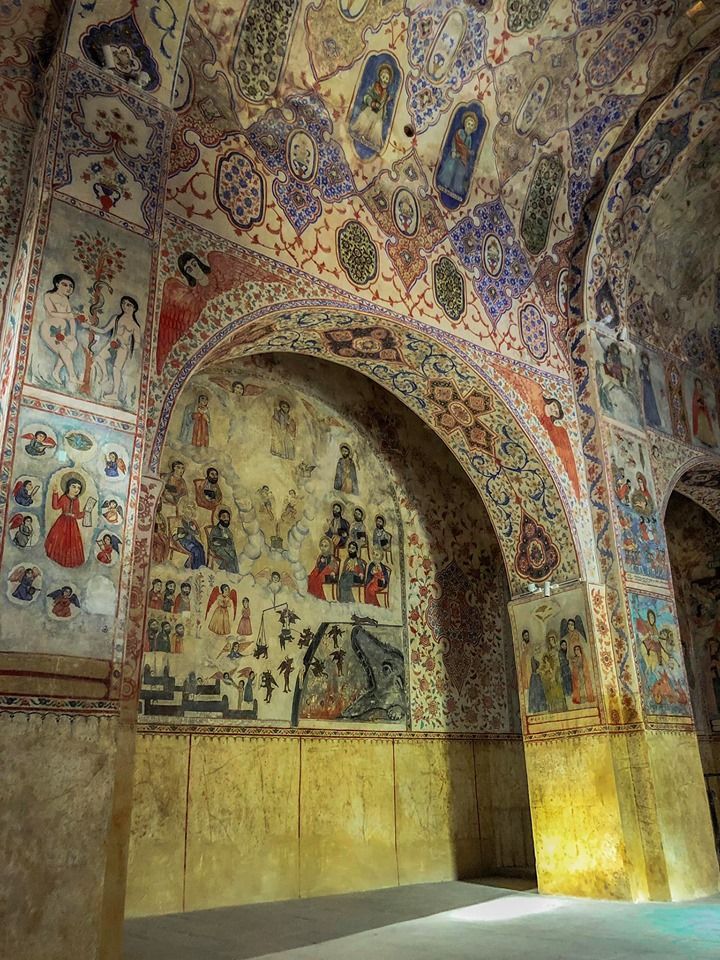 "The Last Judgement" in the St. Hovhannes Church is among the frescos restored through the U.S. Ambassadors Fund for Cultural Preservation (Photo: panorama.am)
"The Last Judgement" in the St. Hovhannes Church is among the frescos restored through the U.S. Ambassadors Fund for Cultural Preservation (Photo: panorama.am)
Video
Join our community and receive regular updates!
Join now!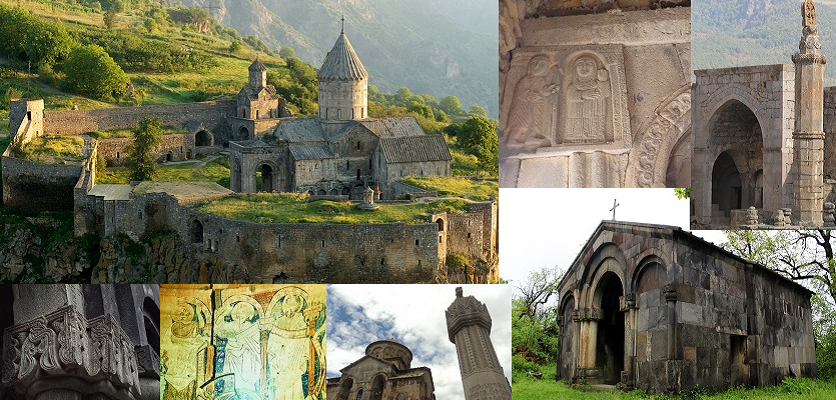
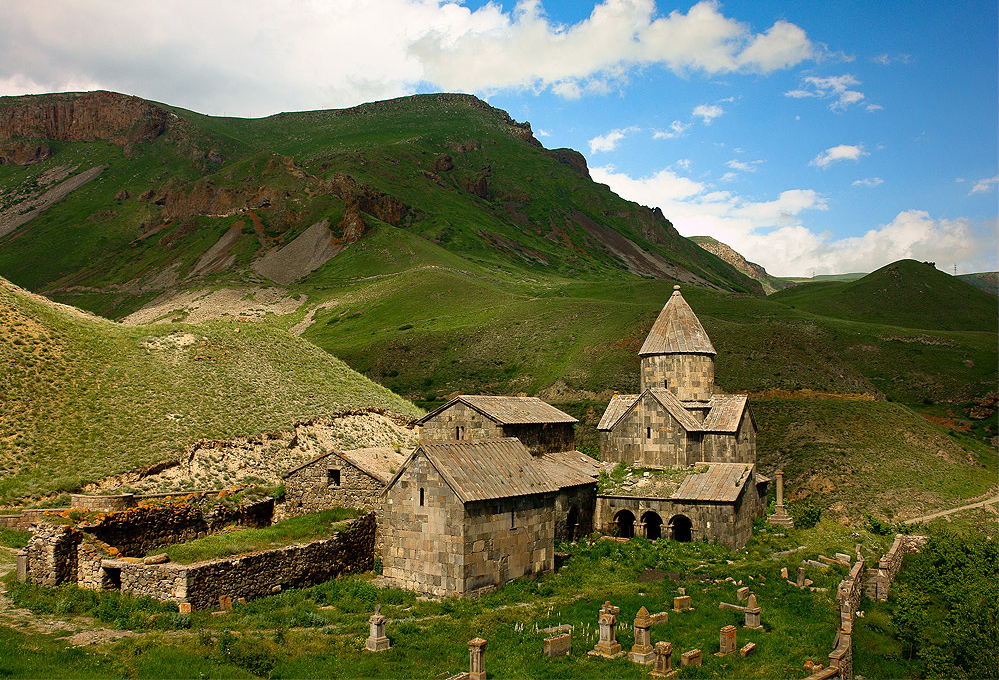








Attention!